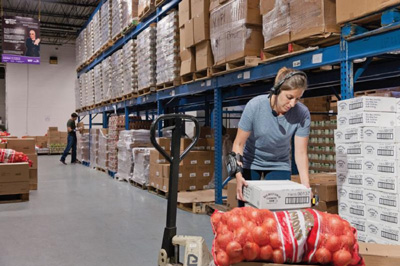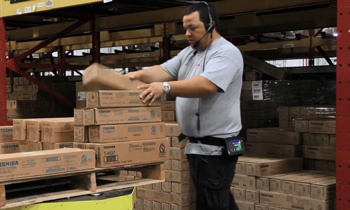How Supply Chain Technology is Changing the Warehouse for Good
 Year after year, the operations organization is challenged to increase efficiency in its warehouses and distribution centers. But with mounting pressure to squeeze five percent or more productivity out of workers every year, warehouse managers have turned to new supply chain technologies to turn this goal into a reality. Achieving this consistent growth trajectory is no small feat; it’s dependent on both management and workers’ communication and the technologies they use.
Year after year, the operations organization is challenged to increase efficiency in its warehouses and distribution centers. But with mounting pressure to squeeze five percent or more productivity out of workers every year, warehouse managers have turned to new supply chain technologies to turn this goal into a reality. Achieving this consistent growth trajectory is no small feat; it’s dependent on both management and workers’ communication and the technologies they use.
Historically, warehouses have relied heavily on manual processes, but with the wide scale adoption of mobile computers, warehouse operators have taken great strides in modernizing the picking and other warehouse processes. Still, even with the help of these contemporary devices, picking can be a time-consuming and labor-intensive task.
To start, warehouse workers walk between seven and 15 miles every day just to locate specific items. Upon finding the goods, they are required to utilize barcode or key-based data entry on their mobile computers to document them, which may force workers to put down the tote holding the parts, enter the information and pick the tote back up – adding valuable time to each pick. Additionally, in some warehouses, it’s mandatory to have picks verified by a manager or colleague before moving on, adding yet another costly step to the critical process.
Although mobile devices have helped expedite the picking process, the rise of e-commerce has driven the need for even bigger warehouses and more workers. In the last ten years, distribution centers have doubled in size. A few short years ago, a 500,000 square-foot building was large enough for some of the largest distributers. Now, warehouses in the U.S. are built to be mega-distribution centers that boast one million square feet of space. But the items inside these gargantuan distribution centers won’t pick themselves – more space means more workers.
Every holiday season, big-box stores hire thousands of seasonal warehouse workers to shoulder the influx of orders coming through. In 2015, Amazon announced its plan to hire 25 percent more workers than in previous years – totaling an astounding 100,000 workers.In comparison, other large retailers like Wal-Mart, Macy’s and Target hired between 60,000 and 85,000 seasonal workers. But even as these warehouses grow in workforce, it doesn’t necessarily mean they are increasing productivity.
In a 2014 survey conducted by VDC Research Group, 50 percent of enterprises reported customer demand for faster orders has exerted strong pressure on warehouse operations. As a result, there’s an increasing need to boost productivity and accuracy. One way to do this is with the introduction of voice enablement. Adding voice allows mobile workers to easily and safely enter data while walking from one aisle to the next without stopping. As a result, voice enablement software can help boost productivity gains anywhere from 20 to 50 percent.
 Toshiba America Business Solutions (TABS), Inc., a global leader in helping businesses manage their communications from paper to digital, was looking for a way to modernize the picking process at its distribution center in Memphis, Tenn. and turned to Wavelink’s Speakeasy voice solution to increase efficiency and simplify the process of filling orders, while automating the quality control step.
Toshiba America Business Solutions (TABS), Inc., a global leader in helping businesses manage their communications from paper to digital, was looking for a way to modernize the picking process at its distribution center in Memphis, Tenn. and turned to Wavelink’s Speakeasy voice solution to increase efficiency and simplify the process of filling orders, while automating the quality control step.
Having studied various traditional voice solutions in the past, the Toshiba team wasn’t comfortable with the products or the high costs associated with them. When it was time to do a hardware refresh they wanted to look at the latest software solutions. Ultimately, the team selected Speakeasy because it “offered everything we were looking for at a very good price. So it was an easy decision to make, and it’s a good thing we did,” said Daniel Sanders, director of distribution at TABS.
The Wavelink Professional Services team developed and deployed the solution in conjunction with other Wavelink products to ensure simple implementation and results for the TABS team. Speakeasy was implemented on top of the Wavelink Terminal Emulation client, which provides the interface back to Toshiba’s Warehouse Management System (WMS). Avalanche, Wavelink’s Enterprise Mobility Management solution, managed the entire deployment process.
Speakeasy’s benefits were felt immediately after being integrated into the warehouse. For the first time, TABS pickers were able to enter data via a Bluetooth ring scanner and enter and receive data through headsets. Because of this hands-free, multi-modal environment, pickers now have the flexibility to watch where they are walking and can use both hands to pick parts. With wrist-mounted mobile computers, pickers receive instructions directly through their headsets – via text-to-speech – and enter data via speech-to-text by simply speaking into the headset.
By using this technology, TABS was able to eliminate the time-consuming second verification step. Rather than require a separate step, the quality control check happens in tandem with the picking. After an item is picked, Speakeasy runs a check digit against the host to confirm the correct items and quantities are in order. As a result of removing the second verification step, productivity in TABS’ warehouse increased up to 25 percent, while preserving the team’s 99.8 percent high accuracy rate. Overall, productivity was improved and warehouse managers were able to reassign employees previously tasked with owning quality control.
An additional benefit of Speakeasy is that it passed Toshiba’s Lean Six Sigma process, a methodology that relies on a team effort to improve performance by routinely removing waste. Thanks to Speakeasy, the TABS team is anticipating projected annual savings of $549,548 in productivity, training and audit costs alone. “The solution paid for itself in fewer than three months,” said Sanders.
Warehouses and warehouse workers have played a critical role in operations since grain storehouses in Ancient Egypt, and will continue to do so – especially as warehouses grow in size and workforce. If companies continue to expect increasing productivity gains, year after year, they will need to invest in technologies like voice enablement that optimize efficiency and in return, save money.
---
 About Robert DeStefano
About Robert DeStefano
Robert DeStefano is an Enterprise Mobility evangelist with 15 years of experience in the mobile productivity space. Storytelling is a passion for him - whether in written form, or in front of a live audience. Sharing the successes of customers, the value of technologies, and serving as the "guiding light" for prospective customers are all core elements of how Wavelink helps prospects shape their mobile productivity vision. His background includes positions at Motorola Solutions, InVision Software and Symbol Technologies. He also has a degree from the NYU Leonard Stern School of Business.
---
Other Bar Code news articles that may interest you:
